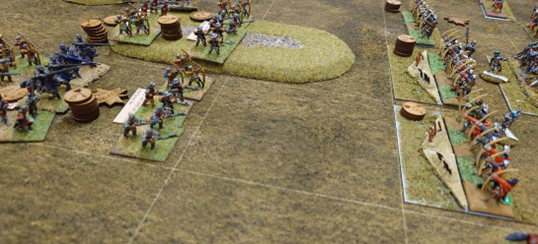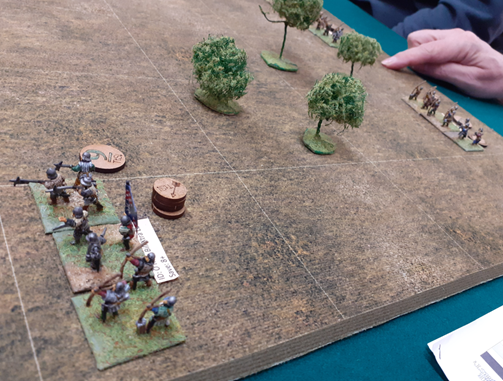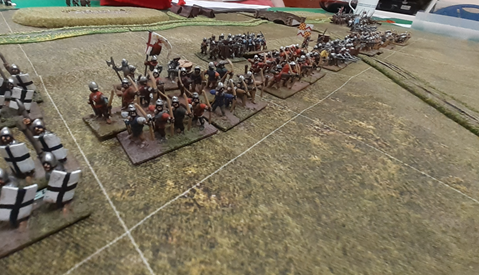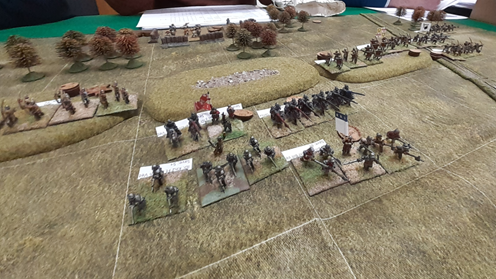The third game in our Wars of the Roses campaign
was Ludford featuring the Yorkist Edward Plantagenet, Earl of March (David) versus
the Lancastrian Henry Percy, Earl of Northumberland (Reg/Doug).
Historically on the night
before the battle of Ludford Yorkist troops began to desert because they knew
Henry IV (God's anointed) was with the Lancastrian army and they had been
offered royal pardons for their treachery. Faced with the loss of their
army the Yorkist leaders tried to pull a fast one and declared that the King
was in fact dead.
With the appearance of Henry
the following morning this was proved to be a lie and many of the best Yorkist
troops defected to the Lancastrians. The Yorkist leaders, seeing that the
game was up, deserted their troops leaving them to their fate.
Having swept away the
remaining Yorkist forces the Lancastrians simply got on with sacking and
pillaging the surrounding countryside.
Remember this game was NOT meant
to be an historical replay. The aim was to kill as many of the enemy as
possible.
Prior to the game both sides
adopted novel approaches to their army selection. The Lancastrians went for a strong force of double
armed (bill and longbow) men-at-arms and the Yorkists chose to go for four
Generals rather than the usual three.
The Yorkists therefore fielded four Commands in columns B+C, D+E+F,
G+H+J and K+L.
Both armies relied on
their mounted infantry to scout the area and gather intelligence on the
opposition, fielding a modest 3 scouting points each. After some rather half hearted scouting (David
drew a 2 chit and Doug/Reg a 3 chit) it was apparent that the Lancastrians had
won (just) the scouting. Edward (David) therefore began the set up.
Edward (David) started by deploying
a strong left wing with a front line of retinue longbows behind stakes,
supported by billmen and handgunners. This command was led by William Neville,
Baron Fauconberg (Mal). Percy (Doug/Reg)
replied by placing a deep formation of billmen closely supported by the army’s
cavalry directly opposite them. This
command was under Percy’s (Reg’s) personal command.
Edward (David) then deployed his
camps in his centre right deployment zone.
Both camps were heavily defended by artillery and longbowmen behind
palisades. The camps were commanded by Baron Scrope (Tony). In light of the extensive beaten zone of the
Yorkist artillery Percy (Doug/Reg) deployed a holding force of shire levy
stiffened by a unit of Welsh spearmen on his left flank. This force was under the command of Baron
Clifford (Adrian).
Edward then deployed his centre
left command, extending the line of longbowmen on his left flank and backing it
up with the remainder of his billmen. This command was placed under the command
of Baron Bonville (David). Against this
command Percy (Doug/Reg) deployed another of his deep bill/longbow formations
under the command of William Tailboys (Doug).
Completing the deployment Edward
placed his mounted bodyguard on his extreme right under his personal command
(Tony)
As battle commenced a signal arrow
rose from the ranks of the Lancastrian army.
Treachery! Lord Fauconberg about
faced his billmen in the centre of the Yorkist left and made to leave the
battlefield. The Yorkist left was now
leaderless and out of command!
Having seized the initiative, the
Lancastrians advanced on both left and right wings while their centre inclined
right in support of their main assault.
The Yorkists replied with longbow and
artillery fire. The first disorder
started to appear in the Lancastrian ranks.
Receiving fire from the
Yorkist bombards, Baron Clifford (Adrian) soon realised the danger to his shire
levies and withdrew them out of artillery range. Meanwhile, acting on his own initiative, Sir
Christopher Curwen (Adrian) led his troops up the extreme left hand side of the
table aiming to stay outside the
artillery field of fire and challenge the Yorkist Right flank (Tony).
Percy (Reg) pressed his attack on
the Yorkist left, attempting to ride down the handgunners in front of him and
forcing them to evade away. The flank of the Yorkist firing line was now
becoming dangerously exposed.
The Lancastrian centre (Doug) continued
to move forward in support of their right wing.
The Yorkist reserves (David) were
now hastening to back up their threatened left wing and to counter Sir
Christopher’s (Adrian’s) brave attack on the right. The treacherous Baron Fauconberg was forced
to halt his cowardly retreat as Yorkist billmen streamed across his front.
The Lancastrian cavalry (Reg) continued
to drive back the Yorkist handgunners forcing them back across the river Teme
but the cavalry were now becoming dangerously over extended.
Baron Bonville (Doug) in the
Lancastrian centre now moved into position to engage the Yorkist line in an
archery duel.
On the Yorkist left Sir Christopher
(Adrian) moved within archery range of the Yorkist flank guard (Tony). Baron Clifford (Adrian) and the remaining
units of his left wing began a slow lateral move towards the centre of the
battlefield and the safety of their camp.
The decisive action of the battle
was now beginning on the Yorkist right. Both
armies came together and the subsequent exchange of arrows and blows caused
disorder to spread through both forces.
A storm of arrows was unleashed against
the Lancastrians advancing through the rolling ground in front of the Yorkist
firing line. Under unimaginable pressure
the Lancastrians broke and fled. Despite
this the Yorkists were not having it all their own way and the disorder in
their ranks was spreading.
A blast of brazen trumpets sounded from the
Yorkist line. Treachery! Baron Clifford (who had now successfully
moved his troops into defensive positions around the Lancastrian camp) turned
to leave the battlefield. His troops were left leaderless.
In addition to this hammer
blow the Lancastrian cavalry, struck in the flank by Yorkist bills were driven
from the field in disarray.
At this point it became clear that the Yorkist
Flank March stratagem had failed and
that the flanking unit had, apparently, become lost. Nevertheless the Yorkists were still enjoying
success on the field. Baron Bonville’s
(Doug’s) centre column suffered it’s first loss.
Baron Bonville’s (Doug’s)
billmen were now coming into action, but was it too late? It certainly seemed so as the Yorkist flank
attack appeared exactly where expected.
Clearly they had not been lost, merely delayed.
As the sun set in the West
Sir Christopher’s (Adrian’s) gallant shire levy lost their archery duel against
the Yorkist right (Tony) and fled the battlefield.
Darkness fell drawing a veil
over the battlefield and a Yorkist victory.



















































